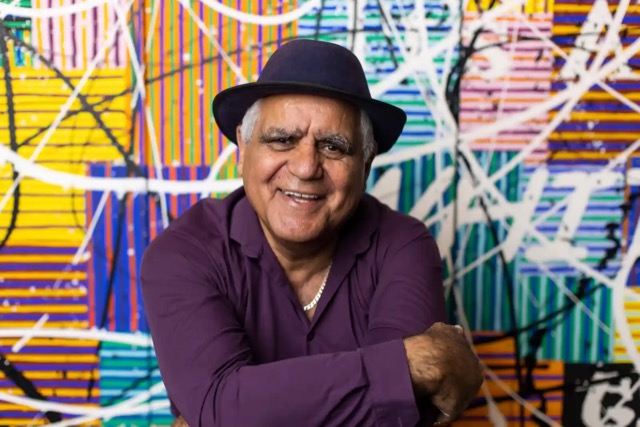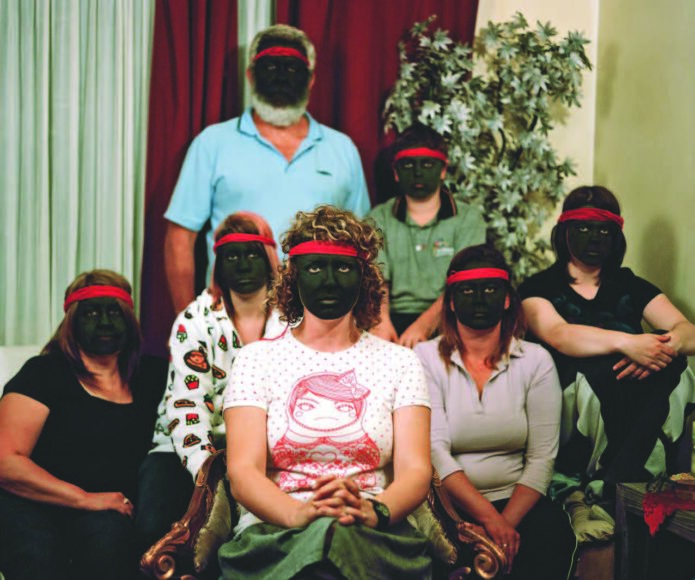 Richard Bell. Photo: Anna Kucera
Richard Bell. Photo: Anna Kucera Richard Bell
Richard Bell (1953) is an artist working across painting, installation, performance, and video. He is a descendant of the Kamilaroi, Kooma, Jiman and Goreng Goreng peoples. Bell grew out of a generation of Aboriginal activists and has remained committed to the politics of Aboriginal emancipation and self-determination. He was an activist and community worker for the New South Wales Aboriginal Legal Service in the 1980s before becoming a full-time artist and co-founding the Aboriginal art collectives Campfire Group in 1990 and proppaNow in 2004. Bell is one of Australia’s most significant artists and his work explores the complex artistic and political problems of Western, colonial and Indigenous art production. In 2003, Bell was the recipient of the Telstra National Aboriginal Art Award. He lives and works in Brisbane, Australia.
In 2021, The Museum of Contemporary Art Australia presented the exhibition, Richard Bell: you can go now, the largest Australian solo exhibition of his work, bringing together over 30 years of the artist’s practice.
He has presented his work at Padiglione d’Arte Contemporanea Milan (2019); Gertrude Contemporary, Melbourne (2018); Art Gallery of New South Wales, Sydney (2017); and Stedelijk Museum Bureau Amsterdam (2016); the 20th Biennale of Sydney (2016); the Jerusalem Show VIII (2016); Performa 15, New York (2015); 16th Jakarta Biennale (2015); 8th Asia Pacific Triennial of Contemporary Art, Brisbane (2015); Aboriginal Art Museum Utrecht (2014-2015); Perth Institute of Contemporary Arts (2014); Sakàhan, the National Gallery of Canada’s largest show of international Indigenous art, Ottawa (2013); and the 5th Moscow Biennale of Contemporary Art (2013).
The Aboriginal Tent Embassy celebrated its 50th anniversary in January 2022. It has been long years of resistance since First Nations activists set up camp under a beach umbrella in front of Parliament House in Canberra, Australia. Since 1972, the Tent Embassy has inspired camps across the continent, operated in a number of locations and took many forms.
Bell’s Embassy project was created in 2013, the installation consists of a canvas tent surrounded by protests signs. It is inspired by the original Aboriginal Tent Embassy, which was pitched on the grounds of Canberra’s Parliament House in 1972 by four young activists. The group were opposing new government policy preventing Aboriginal and Torres Strait Islander land ownership. Attracting attention across Australia and internationally, their protest placed Indigenous land rights, health and housing at the forefront of Australian politics. Bell’s Embassy has been invited into some of the most significant international exhibitions and venues of the past five years, including: the Moscow Biennale curated by Catherine de Zegher (2013); Performa 15, New York City (2015), curated by Rose Lee Goldberg; the 16th Jakarta Biennale, curated by Charles Esche; the Sonsbeek International in Arnhem, Netherlands, curated by ruangrupa; BELL Invites… (2016) an exhibition of Bell and work by friends and collaborators opened at the Stedelijk Museum Bureau Amsterdam (SMBA). In 2016 Embassy was presented as part of the 20th Biennale of Sydney, curated by Stephanie Rosenthal; the Cairns Indigenous Art Fair (2016); the Institute of Modern Art, Brisbane; the Jerusalem Show VIII curated by Vivian Ziherl. In 2017, Embassy travelled to e-Flux, New York City, in the Toxic Assets exhibition, and the Indigenous New York, Artists’ Perspectives program curated by Alan Michelson at the New School.
